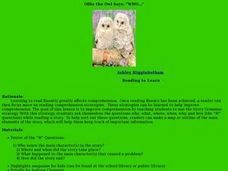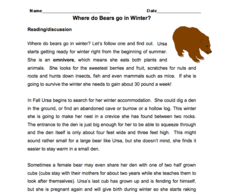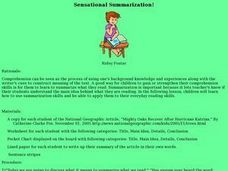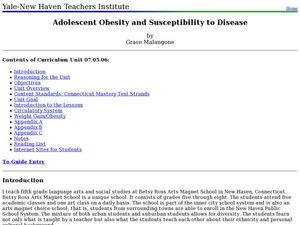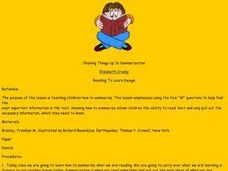Curated OER
Questioning
Practice making predictions by looking at the cover of a book. You can use The Hungry Thing, as suggested here, or any other book you may be reading in class. Use the predictions to talk about good reading strategies. A chart is...
Tompson Solutions
Be a Reporter (The 5 W's and an H)
Teach your class how to investigate research sources. You can start out with this presentation, which lays out a easy strategy for asking questions and taking down answers that cover the important information.
Curated OER
Ollie the Own Says: WHO
Scholars examine the strategy of making a story map or outline to identify the main elements of a story. They discuss the who, what, where, when, why, and how of a story, in an outline form. As a class they read a short story, answer the...
Curated OER
Comprehending Through Questioning
Elementary schoolers observe and apply a variety of reading comprehension strategies. They silently read a passage out of their science textbook, and discuss answering the who, what, where, when, and how of the text. In small groups they...
Curated OER
Build Masters: Identifying Details
Find key details in books using this note card strategy. Each reader gets six cards with the classic who, what, where, when, why, and how detail prompts. After they read the book, they choose a card and locate a key detail...
Curated OER
Five Big W's
Students develop summarization strategies by asking themselves questions as they read. They devlop these strategies help them develop better comprehension. Students goals for reading is comprehension. They explore helpful...
Curated OER
The 5 W's of Reading
Primary young scholars will use the five "W" questions for reading comprehension as they read silently to themselves so that they can understand and remember what they have read. They then read The Velveteen Rabbit aloud, discussing the...
Curated OER
5 W Questions
Second graders practice asking the 5 W questions by reading a Boxcar Children book. In this journalism lesson, 2nd graders read a single story from the Boxcar Children series and answer the 5 W's about each specific chapter....
Worksheet Web
Let it Snow
After reading an informational text detailing the ins and outs of snowflakes, scholars draw their own special design then work cooperatively to role play a snowman building scenario.
Worksheet Web
Where do Bears go in Winter?
Do bears really sleep for an entire season? Six multiple choice questions and a drawing activity make up a worksheet that tests scholars' comprehension skills after reading about bears during winter.
Super Duper Publications
How to Help Your Child Understand and Produce “Wh” Questions
Practice who, what, where, when, and why with a series of activities designed for forming and answering questions. Kids work on choosing the correct wh- word to ask the question they want with a word chart,...
Curated OER
Sum It Up !!
Students practice various comprehension strategies to generate the main idea of the text. They encounter unfamiliar concepts and new vocabulary in their quest of the main idea in "Watson's Goes to Burmingham." The Five W's (What, Where,...
Curated OER
The Five W's!
Students explore reading comprehension strategies. They discuss the story-grammar strategy. Students discuss the importance of comprehension. They discuss questions they should ask while reading a text. Students read a story and stop to...
Curated OER
Summing It All Up in a Nutshell
Students observe and demonstrate a variety of summarization strategies. They discuss the process of asking the five W questions, and apply then to a passage from the book "Sarah Plain and Tall." Students then finish the chapter from...
Curated OER
Reader R.E.A.C.T.I.O.N.
Learners practice their reading comprehension skills. In this reading skills lesson, students use the R.E.A.C.T.I.O.N. model to identify story elements in books that learners elect to read independently.
Curated OER
Sensational Summarization!
Students observe and demonstrate a variety of summarization strategies. They silently read an article from National Geographic Kids, and as a class write a summary that includes the main idea and details and the five W's. Students then...
Curated OER
It's Raining Meatballs
Students observe and demonstrate the process of summarization using the book "Cloudy With a Chance of Meatballs" by Judi Barrett. They silently read the story, and as a class discuss the five W's. Students then write a short summary of...
Curated OER
Prewriting
As a class, 7th graders observe examples of brainstorming and then complete brainstorming worksheets themselves. They compose and describe planning strategies. Prior to writing an essay, they identify the purpose and the audience.
Curated OER
Adolescent Obesity and Susceptibility to Disease
Students understand the importance of maintaining a healthy weight and good health. In this health instructional activity students read text then create their own pamphlet on the cardiovascular system, weight gain, treatments and...
Curated OER
Newsworthy Fairy Tales
Third graders review common fairy tales and work in teams to rewrite the fairy tales as news articles. They answer questions using the 5 Ws (who, what, where, when, why). Student articles include eye-catching headlines.
Curated OER
Living Longer
Students relate health information text to themselves and society. In this health information lesson, students answer questions using the 5 W's based on the health issue they are reading about. Students discuss life...
Curated OER
Summarization Safari
Young scholars summarize a piece of fiction text. After reviewing the correct way to question while reading, students independently read a short story. They complete a summary organizer using the five Ws outlined by the instructor during...
Curated OER
Shaking Things Up In Summarization
Students practice several techniques and strategies to become better at summarizing a piece of writing. They emphasize the five "W's: who, what, where, when and why. A book of Earthquakes is read and then summarized by each of the students.
Curated OER
Summarization
Pupils summarize a selected piece of text using the five Ws. After reviewing the correct way to read silently, students read a selected piece of nonfiction text. They write a summary paragraph using a process outlined by the instructor.


